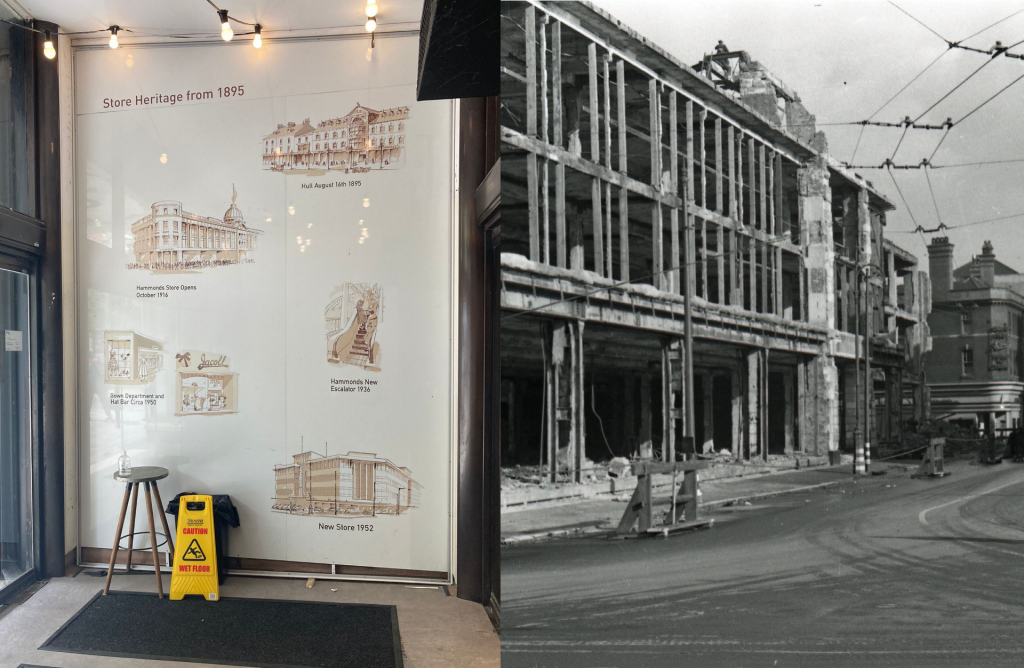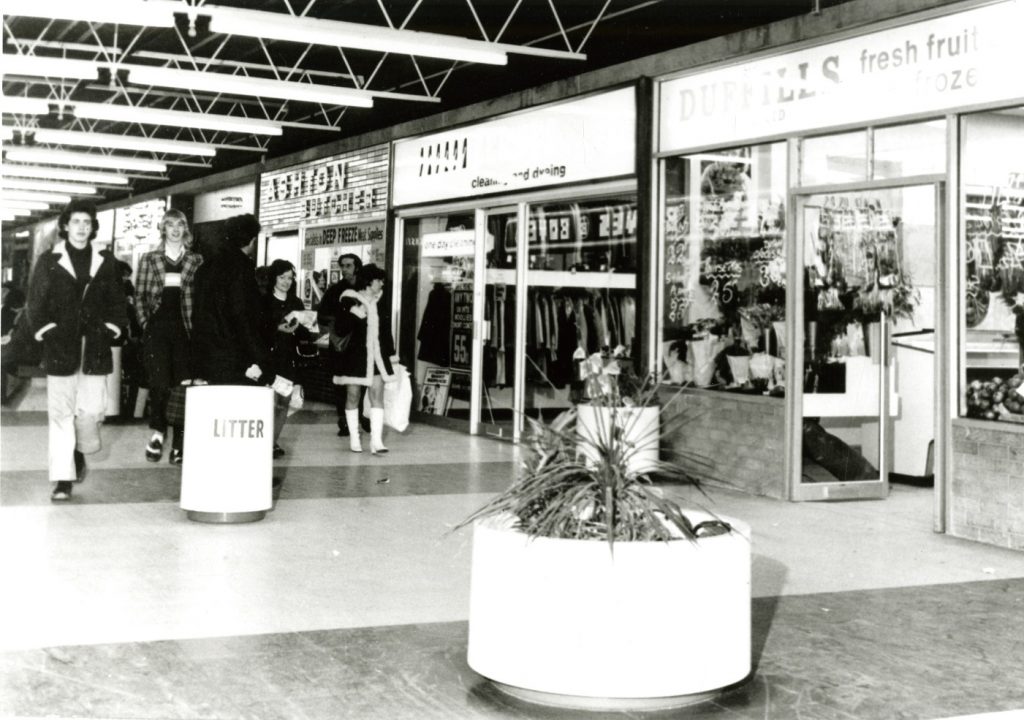Last month, when we released our Hull Mixtape, along with clips and extracts from our workshops and oral histories, you told us that you’d like to see more posts like this, sharing snippets from the stories we are collecting in our project. This week, we’re delving into one of our most-discussed topics – shops and shopping – in the words of those who’ve told us their stories of post-war Hull.

The most important question of all – is it Boys, Boy-ez, or Boyziz?
In our oral histories about people’s lives in Hull, conversations can go in a great number of different directions. Some people talk about their working lives, or their families, moving to the city or moving away, things that stand out in their memory, or things that have only come back to them as we move through the interview questions. These oral histories often start with some basic information – When were you born? Where were you born? What did your parents do? Where did you grow up? They also often end with a recurring question – How has Hull changed in your lifetime?
In answer to this question, there is one topic that is brought up more than any other – shopping. Favourite places to browse, Saturday rituals of going shopping in town, going ‘on road’, and old stores that were much-loved and are now much-missed come up again and again. Shopping cultures and the high street have changed enormously over the last eighty years, and in this blog post, we want to share some of the stories that we’ve collected so far on this theme. In the following extracts and sounds clips, you’ll hear more about what it was like shopping on the Avenues in the 1940s, in Hull City Centre in the 1950s, on Holderness Road in the 1960s and Hessle Road in the 1980s, as well as how that legacy shapes people’s attitudes to the city today.
The big department stores of Hull are mentioned frequently in our oral histories and workshops. Shopping in these places could be a weekend tradition for people that is still remembered fondly years later:
“Saturday was my favourite day of the week. From age 12 I was allowed to go into town with friends. We would go to Picadish in Hammonds for a sausage and chips and then spend ages listening to music in the booths in the record dept.”
Stores like Bladon’s in Hull’s City Centre had their own specialities and quirks that mean they stand out in people’s minds:
‘And eventually we’d emerge, and we’d probably go further up the road, across the road and we’d go into Bladon’s. Now there were three stores as we all remember, there was Bladon’s, there was Thornton Varley’s, and there was Hammonds. And each had their own specialities, Bladon’s was more or less furniture, Hammonds was, all sorts, as it always was. Sadly it isn’t there any more, it feels as though the heart of Hull went when Hammonds went. But Thornton Varley’s was very good because, ladies used to buy their hats there, and the Thornton Varley’s hat box I think it’s now a collector’s item. Erm, there was other things, obviously other things there cos it was a department store, and it later became, what’s Thornton Varley’s now? It’s just closed down, I cant remember it’s name now. Anyway it doesn’t matter. But one thing that fascinated me about being in Thornton Varley’s was the way they took the money. One day we went in and under normal circumstances in those days if ladies didn’t pay by cash they paid with a cheque. But this place, was a bit different because there were all these strange pipes and tubes all round the ceiling and all round the place, and there were, funny whistling noises and chains being pulled and I thought “What on earth is this?”, it looked like some sort of weird railway in the sky, in the air. What it was of course was when you went to buy anything you paid your money, and the assistant issued the invoice, put the money in a little tube, screwed the end of it, pulled the lever and this thing disappeared up these tubes to a cashier, ooh about, a few hundred yards away in a corner. Where the money would be taken out, any change would be issued, and the receipt would be duly stamped. And it would come whistling back, fascinating.’

Left: The history of Hammonds represented inside the building today. Right: Hammonds Department Store in the aftermath of the Blitz, photo from the Hull History Centre.
Shops could be much-loved and much-used by locals, but also by visitors. One of our interviewees, who frequently travelled ‘home’ to Hull to visit her family, remembers her Mum stocking up on local delicacies to take back with her:
“My mum bought Tomato Paste and Potted Meat to take back to Stafford. She’d make sandwiches and freeze them for packed lunches. I can still taste the tomato slices they sold too. My mum used to buy offal – cow’s udder on Hessle Road to take back to Stafford too.”
Memories of shopping are not limited to the city centre, but span across the whole city. In particular, people have often told us about shopping ‘on road’ (usually Holderness Road or Hessle Road), or along ‘the Avenues’:
“It was lovely, it was absolutely lovely. In fact, and I’m not being snobby here at all, cos, I’m just not, but Newland Avenue was quite a posh area, streets were lovely, the people were. We had proper shops, proper houses on the Avenue it wasn’t all cafes and things…Oh the shops were lovely. We had dress shops, we had every so many, well they’re not like supermarkets like you know them today, but big stores, that, but you always got served they weren’t self service. We had a big co-operative, we had a place called Cousins, Home and Colonial, ooh, what else did we have? We had several of them of the corners of the streets, we had lots. We had nice little shops as well, beautiful hat shop and that kind of thing, selling all those sort of things. We had three or four wet fish shops, lots of butchers. Another school, we had a school, a big school on the Avenue. Lots of fish shops, we only have one now and that’s just been closed down I don’t know whether it’s opened again. Err, not cafes and things like that, well we had a few but nothing, nothing like this, they’ve turned it into a, like Princes Avenue, a café takeaway area.’

Photo from our project partners the Hull History Centre.
When looking back, people remember the constant activity of shopping streets, filled with people who gave the city a bustling and energetic atmosphere. Changes in working habits, transport, and domestic technology like fridges and freezers have radically altered the way that people shopped since the mid-century:
‘The shops aren’t the same, um, people don’t use them the same either. I mean now, with everyone going in cars the way that they do, and, particularly with women having to work, it’s a big difference. You used to, you used to have Holderness Road thronging with busy housewives who had to come out each day to get the fresh meat, the fresh fish, because you know, there weren’t freezers, there weren’t even fridges at one time. I mean Mum used to come out every morning and walk across the park and go to the fish shop, you know, to get fresh fish for the cat, and um, everything that she needed. Well, that core of people, now, either do it by car going to a supermarket or they’re at work, and you know. So it’s not the sort of busy thriving place that it was.’
These sort of shopping habits also supported a sense of community in areas of Hull that now is considered lost by many. One of our interviewees remembers shopping with her grandmother in relation to changes to Hessle Road:
‘She always used to take me shopping, we used to go down and help her to do her shopping, take a shopping trolley out and whenever you went down road, you didn’t get very far, it always took hours cos it was stop-start-stop-start cos she, you knew everybody, d’you know? Also, down Hawthorn Ave we used to sometimes go to like this little cake shop, I think it was either a McLeish’s, Skelton’s or a Fletcher’s I cannot remember but it was on like a little corner, and if it was, if we’d had, if it was like a little treat time we’d go down there…I’d love to be able to go back in time, and see Hessle Road when it was the hustle and bustle of Hessle Road, do you know, not what I’ve witnessed as I’ve seen it decline.’
In present-day Hull, like in other cities, high streets, former department stores, and shopping districts face enormous challenges. In a previous blog post, we chatted to Leigh Bird and Esther Johnson about their work to protect the heritage and legacy of Hull’s Central Co-operative/BHS building. While some former stores are being demolished, others are being protected, and some are being repurposed or revived with sympathy to their past lives. Hull’s own Hammonds recently reopened as a food court with nods to the building’s heritage in its name – Hammonds of Hull – and the inclusion of a record department. And this is important to people – a recent report on the historic built environment and civic pride found that it was ‘totemic’ shared spaces like department stores and shopping streetscapes that were the most significant places for people, reminding them of a communal past, and evoking notions of familiarity and belonging. As in our oral histories and workshops, it’s the everyday spaces of Hull – the shops, streets corners, workplaces, and pubs – that play the biggest part in remembering ordinary lives in the city.